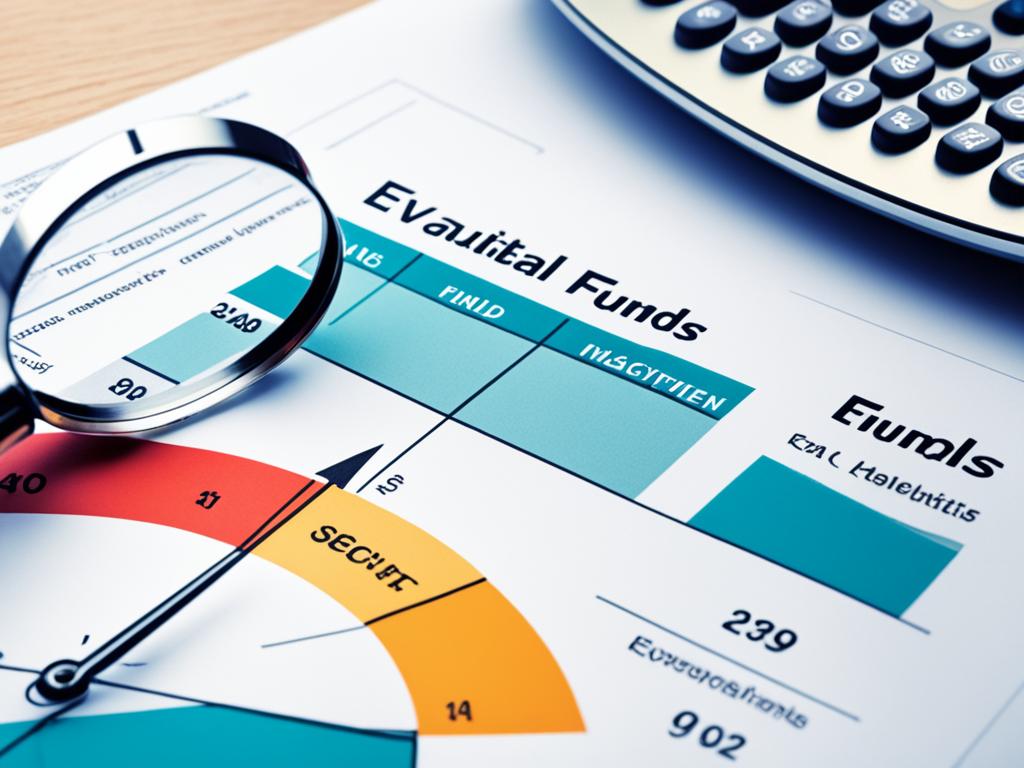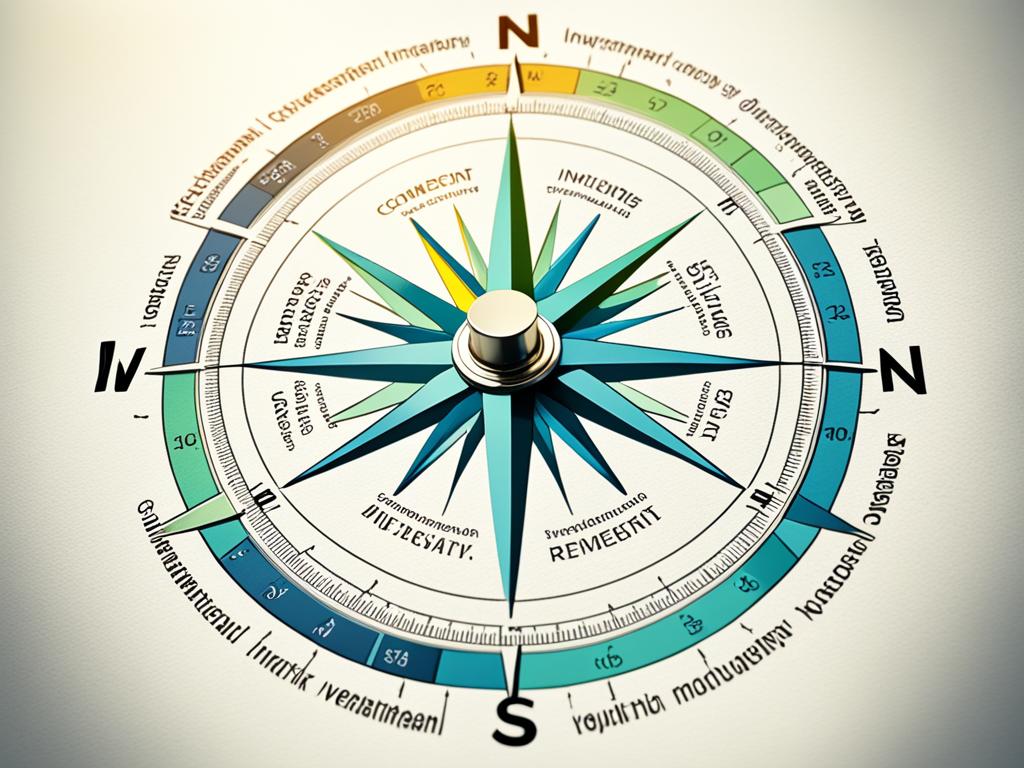
How to Evaluate and Choose Mutual Funds
Investing in mutual funds is a smart way to grow your money and reach your financial goals. With so many options, picking the right ones is key. This guide will help you pick mutual funds that fit your investment plans, how much risk you can take, and your financial goals.

Mutual funds let you put your money together with others to invest in different things like stocks and bonds. By looking closely at mutual funds, you can find ones that might give you good returns and match your risk level and time frame. We’ll look at important things to think about when choosing mutual funds for your portfolio.
Understanding Mutual Funds
Mutual funds collect money from many investors and put it into a mix of stocks, bonds, or money market items. They are managed by experts. This makes it easy for investors to get into many investment areas.
What are Mutual Funds?
Mutual funds let investors join a mix of assets. Each investor gets a share of the fund, showing their part of the portfolio. These funds can go into equity funds, bond funds, and money market funds. They match different investment goals and how much risk you can take.
Benefits of Investing in Mutual Funds
Investing in mutual funds has many advantages:
- Diversification: They let investors spread their money across many investments. This lowers the risk of losing money with just one investment.
- Professional Management: Experts manage mutual funds. They keep an eye on the market and make choices for the fund’s investors.
- Accessibility: Mutual funds are open to all investors. This makes it easier for people to join the financial markets.
- Liquidity: You can buy and sell mutual fund shares every day. This gives investors the freedom to use their money when they need to.
Knowing about the different fund types and the perks of mutual funds helps investors make smart choices. They can use these funds as part of their financial plans.

Defining Your Investment Goals
Choosing the right mutual funds starts with knowing your investment goals and how much risk you can handle. This guide will help you figure out what you want to achieve with your money. Whether it’s building wealth over time, making regular income, or reaching a savings goal.
First, think about your investment goals. Do you want long-term growth or consistent income from your investments? Maybe you’re saving for a big purchase or your kid’s education.
It’s also key to know your risk tolerance. Can you handle the ups and downs of the stock market, or do you want a safer investment? Your answer will guide you to the right mutual funds.

With clear investment goals and risk tolerance, you can pick the best mutual funds for you. This will help you meet your financial objectives over time. It’s all about making choices that fit your unique needs and goals.
Evaluating Fund Performance
Looking at a mutual fund’s past performance helps predict its future success. By checking its historical returns against market indices, investors can see how it stacks up. This helps them understand the fund’s performance and how it handles risks.
Analyzing Historical Returns
Looking at a fund’s past results over various periods is key. Check its performance over 1-year, 3-year, 5-year, and 10-year spans. Find funds that consistently meet their goals and match your risk level. Those with a history of strong performance are likely to keep doing well.
Benchmarking Against Relevant Indices
It’s vital to compare a fund’s returns with the right benchmarks and indices. This shows if the fund is beating or lagging its peers and the market. Aim for funds that regularly outshine their benchmarks.

By looking at a fund’s historical returns and comparing it to indices, investors can make smart choices. They can see if the fund fits their investment goals and risk level.
Assessing Risk Tolerance
Understanding your risk tolerance is key when investing in mutual funds. The risk-return tradeoff is crucial for making smart choices. Equity funds offer higher potential returns but also have greater risk. On the other hand, fixed-income funds are less volatile but give lower returns.
Equity Funds: Higher Risk, Higher Potential Returns
Equity funds mainly invest in stocks and can lead to big gains over time. But, they also come with a lot of risk. The value of the stocks can go up and down a lot. If you’re okay with taking more risk and have a long-term plan, equity funds might be right for you.
Fixed-Income Funds: Lower Risk, Lower Returns
Fixed-income funds like bond funds usually offer a steady and predictable return. They invest in things like government and corporate bonds. These are less likely to change much in value. If you prefer a safer investment or are looking at a shorter time frame, fixed-income funds could be a good choice.

Choosing between equity and fixed-income funds depends on your risk tolerance, goals, and how long you plan to invest. By understanding your own risk tolerance, you can pick investments that match your financial goals. This can help you work towards your financial dreams.
Mutual Funds Fees and Expenses
Investing in mutual funds means understanding the fees and expenses. These costs can greatly affect your investment’s long-term performance. Let’s explore the main fees you should know about.
Expense Ratios
The expense ratio is an annual fee from the fund company. It covers costs like managing the fund, administrative tasks, and other expenses. Higher ratios can reduce your returns over time. So, it’s key to choose funds with lower ratios.
Management Fees
The management fee is part of the expense ratio. It goes to the fund’s managers or advisors. These fees pay for their work in managing the fund and making investment decisions for you.
Sales Charges
Some mutual funds have sales charges, or “loads.” These fees apply when you buy or sell the fund. Front-end loads are for buying, and back-end loads for selling. No-load funds, with no fees, can save you money.
When picking mutual funds, understand the mutual fund fees and expense ratios well. Choosing funds with lower management fees and sales charges can boost your returns over time.

- Look for mutual funds with lower expense ratios to minimize the impact on your returns.
- Understand the management fees charged by the fund’s portfolio managers.
- Avoid funds with high sales charges, or “loads,” if possible, and opt for no-load funds.
Diversification and Asset Allocation
Diversification and asset allocation are key to smart investing. By spreading your money across different types of investments, like stocks, bonds, and cash, you can lower risk and aim for better returns over time. Mutual funds make it easy to diversify by offering a mix of securities in one investment.
Balancing Different Asset Classes
It’s crucial to find the right mix of asset classes in your portfolio. Stocks, found in equity funds, can offer big gains but also come with more risk. Bonds, in fixed-income funds, usually give steadier returns with less risk. Cash funds, like money market funds, can soften the blow during market ups and downs. By spreading your money across these areas, you can build a balanced portfolio that matches your risk level and financial goals.
Incorporating Mutual Funds into Your Portfolio
Mutual funds are vital for your investment plan. They let you tap into a wide range of securities and asset classes with expert management. Adding a mix of mutual funds to your portfolio can help diversify your investments, tap into specialized strategies, and boost your long-term gains. Keeping an eye on and adjusting your mutual fund mix can make sure your portfolio stays on track with your financial goals and risk comfort.
FAQ
What are mutual funds?
Mutual funds collect money from many investors. They then invest in a mix of stocks, bonds, or other assets. Professional managers pick investments for the fund’s shareholders.
What are the benefits of investing in mutual funds?
Mutual funds offer diversification and professional management. They give you access to many investment options. And, they usually have lower investment minimums than buying individual securities.
How do I define my investment goals and risk tolerance?
It’s important to set your investment goals and know your risk level. Think about how long you plan to invest, what you want to achieve, and how you feel about market ups and downs.
How can I evaluate a mutual fund’s performance?
Look at the fund’s past returns and compare them to market benchmarks. This shows how well the fund has done and if it’s beaten the market.
What are the different types of mutual funds?
There are mainly three types of mutual funds. Equity funds invest in stocks. Bond funds invest in bonds. And money market funds invest in short-term, low-risk assets.
How do I understand mutual fund fees and expenses?
Fees and expenses like the expense ratio and management fees affect your returns. Make sure to look at a fund’s costs and how they might change your investment’s performance.
How can I build a diversified mutual fund portfolio?
For a diverse portfolio, mix different asset classes and fund types. This helps manage risk and aim for better returns based on your goals and how much risk you can take.



Mutual funds is really good as it’s helps in future investment